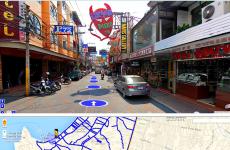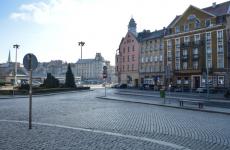How is the hologram illusion made? Self-production of a holographic three-dimensional pyramid. Large 3d hologram with your own hands.
The theory and practice of creating holographic images was first mentioned in the chronicles of the 16th century. The hologram illusion has long been the subject of speculation by scientists, artists and magicians. Engineers have improved devices to reproduce transparent ghosts that appear where there is actually nothing. They developed glass and polymers to produce the clearest projection possible. Motors were used to move the reflection planes, the light intensity was selected, and a multi-level process was created. Now everyone can make a 3D hologram on a tablet, smartphone or computer screen. Let's look at how to make a hologram using a tablet as an example.
How to make a hologram on a tablet or smartphone
To obtain a three-dimensional image, a prism is installed on the device screen, or rather, a tetrahedral pyramid without a vertex. Using a specially prepared moving image displayed on the screen and this prism, you can create a three-dimensional picture. The image, reflected from the planes of the pyramid, appears in the form of a 3D projection.
Prism for hologram
To make a prism, you need to take 4 computer disk boxes with transparent lids. This plastic is suitable for creating a structure that is made as follows:
- We break off the transparent lid from the box and remove the side parts, leaving only a smooth surface.
- Now you need to cut out geometric shapes from the blanks using a stencil.
- We make a cardboard isosceles trapezoid with bases of 2 and 12 cm and a height of 8 cm.
- We apply this stencil to the plastic and outline it with a marker (preferably black).
- Using a metal ruler and a utility knife, we make precise cuts along the marked lines. The force must be significant, or the tool must be passed several times.
- This cut makes it easy to break the plastic. Smooth the edges with pliers.
- It turned out to be 4 trapezoids. They are the same in shape and size. The trapezoids need to be glued together with tape, for which we lay them out on one plane, placing their edges next to each other.
- After turning the resulting flat figure over, we form a volumetric prism from it. Now we secure its ribs on the outside with tape.
 If the hologram is created on a smartphone, the entire structure is made from one CD or DVD box (from smaller trapezoids). To do this, reduce the size of the stencil. The dimensions of the prism for a hologram can be any; they are determined depending on the screen size of the device on which the 3D image will be reproduced.
If the hologram is created on a smartphone, the entire structure is made from one CD or DVD box (from smaller trapezoids). To do this, reduce the size of the stencil. The dimensions of the prism for a hologram can be any; they are determined depending on the screen size of the device on which the 3D image will be reproduced.
Instead of covers from CD boxes, you can use plexiglass or thick transparent film as a material. You can use any plastic, even very thin and flexible, and ordinary glass.
Size rules
 Today you can find a special video for a 3D hologram on the networks. Animated images, usually shown on a black background, are the basis for a 3D projection that will appear in a transparent pyramid. You need to download them and enable them on the device screen. To check the size fits you need to do the following.
Today you can find a special video for a 3D hologram on the networks. Animated images, usually shown on a black background, are the basis for a 3D projection that will appear in a transparent pyramid. You need to download them and enable them on the device screen. To check the size fits you need to do the following.
- Place the smartphone (in this case, tablet) with the screen facing up.
- Place the prism with its smaller base on the screen.
- Look at the image above. The small square (cut from the top of the pyramid) should be approximately 2 times smaller than the distance between the moving pictures.
- The image itself as a whole should not extend beyond the larger square.
- We check the height of the prism by the angle of inclination of the edge - approximately 45°. Then the image will not appear too high, going beyond the transparent structure, or low.
If all parameters are correct, the prism for the monitor can be considered ready and suitable for use when reproducing a three-dimensional image.
The picture created in the center of the prism will attract the attention of both children and adults.
How to make a hologram of yourself
 If you want to make a hologram (3D image) of yourself, you need to hang a black cloth as a background and take a photo, taking several different frames. To begin with, 2-3 photos are enough as a basis for adding movement (animation). You can record a video with your image against a dark background. It is subsequently possible to make a storyboard from it (dividing it into separate frames) and create blanks for a hologram in an animation format.
If you want to make a hologram (3D image) of yourself, you need to hang a black cloth as a background and take a photo, taking several different frames. To begin with, 2-3 photos are enough as a basis for adding movement (animation). You can record a video with your image against a dark background. It is subsequently possible to make a storyboard from it (dividing it into separate frames) and create blanks for a hologram in an animation format.
To create animation you need to know how to make moving pictures. If you don't know this, the idea of making a 3D moving image yourself may not lead to the desired result. Each frame in the hologram is created in advance, and during playback the pictures alternate at a given speed.
 You can use almost any photo editor and animation program. A special picture for 3D includes a photo of a person, repeated 4 times and arranged in a cross shape. These 4 identical images on a black background need to be placed within a square. On the tablet screen, the image will be two-dimensional. Next, you need to look at it from the side through a prism mounted on the screen with a base (square). This will be surprising, since the 3D picture will appear in the prism as if it were real, and not two-dimensional.
You can use almost any photo editor and animation program. A special picture for 3D includes a photo of a person, repeated 4 times and arranged in a cross shape. These 4 identical images on a black background need to be placed within a square. On the tablet screen, the image will be two-dimensional. Next, you need to look at it from the side through a prism mounted on the screen with a base (square). This will be surprising, since the 3D picture will appear in the prism as if it were real, and not two-dimensional.
Where to get ready-made images to create a hologram
 Pictures for reproducing holograms should not be ordinary, but specially prepared. As described above, the image must be symmetrical within a square and consist of 4 identical elements arranged crosswise. You can make such a blank yourself and give it movement, show your artistic abilities, expressing your thoughts.
Pictures for reproducing holograms should not be ordinary, but specially prepared. As described above, the image must be symmetrical within a square and consist of 4 identical elements arranged crosswise. You can make such a blank yourself and give it movement, show your artistic abilities, expressing your thoughts.
Before you try to do this, you need to find ready-made animations and videos for viewing holograms. Then make a prism and acquire your first skill in creating 3D images. Remembering the principle of operation, it will be easier to realize your own ideas.
How to make a large hologram for a laptop?
 The features of the 3D images obtained using the above method are implemented in the form of a large hologram. The template is a trapezoid with a base of 240 mm, an upper horizontal of 40 mm and a height of 140 mm. A chamfer of 45° is made relative to the side edges. Glaziers have glass of this size. They need to be cut precisely, which determines the quality of the 3D picture. So this is easier to implement with plastic.
The features of the 3D images obtained using the above method are implemented in the form of a large hologram. The template is a trapezoid with a base of 240 mm, an upper horizontal of 40 mm and a height of 140 mm. A chamfer of 45° is made relative to the side edges. Glaziers have glass of this size. They need to be cut precisely, which determines the quality of the 3D picture. So this is easier to implement with plastic.
We carefully glue the ribs with silicone. Cut out 1 cm strips from double-sided tape and cover the top edge of the glass. Next, we turn on the picture for 3D images on the entire screen. We place a pyramid on it with a smaller square. The tape will help prevent scratches. We combine the edges with the white diagonals and start the video in a dark room.
A little history
The hologram illusion has been around for a long time. Similar equipment has been used in theaters, parks, museums and concerts since the 19th century. The effect was called Pepper's Ghost after the scientist D.H. Pepper, who spread the phenomenon through demonstration. This was in 1862, and today the art of holograms has reached perfection. The world began to become acquainted with the phenomenon back in the 16th century, when the Neapolitan scientist Giambattista della Porta developed an illusion camera. He also wrote the work “Natural Magic”, which is the first mention of the reproduction of illusions. The scientist considered the question of how objects that are not actually there can be seen in the camera.
The Polytechnic Institute in London is a scientific institution where D.H. Pepper worked in 1862. At the same time, the inventor G. Dirks practiced the technique of appearing a ghost on stage in a play. He tried unsuccessfully to sell his idea to theaters. This required a complete overhaul of the stage, and the effect was deemed too costly. Dirks then set up a stand at the Polytechnic Institute, where Pepper observed him. The scientist had the intention to modify the method, after which the phenomenon began to be used in cinemas. So the phenomenon gained significant success, and the world learned about it in detail. D. Pepper's improvement of the phenomenon led to it receiving his name, and Dirks transferred to him all financial rights in a joint patent. People, attending various shows, allowed themselves to be deceived, since it was believed that the phenomenon was created by geniuses.
Modern Application
Modern examples today include transparent and translucent attractions in the Walt Disney parks. The world knows them as the largest implementations of this idea. Several effects are collected on a long stage. A giant 9.1 m hologram is viewed in an empty ballroom. Animated ghosts move in hidden black rooms. The most modern version is used in the Twilight Zone Tower of Terror.
The Nashville attraction uses a classic technique, allowing guests to see spirits interacting with the environment. They can be seen especially close. California also has a Halloween attraction in the Forest Mountains featuring story characters. Projecting an image onto the floor and reflecting it in glass allows a live actor to interact with the ghost, which is used in plays. The world can see the phenomenon in the Netherlands, Australia, America, museums, parks, science exhibitions and attractions. Illusion finds application in various fields:
- Television and cinema use the method to broadcast programs and create effects.
- Sometimes the phenomenon is used for commercial purposes to attract visitors.
- It is often used at music concerts. But in this case, the images are often projected rather than holographic. Entire installations run on special software.
- Political speeches allow you to reproduce figures in several places at once. This effect was used in India during the speech of Minister Narendra Modi.
- Scientific philosophy uses a holographic model of the Universe, where each part of the 3D image contains information about the whole picture. This helps to study the world in detail.
The story about creating 3D images should end with a phrase from the character Bill Cipher from the animated series Gravity Falls: “Remember that reality is an illusion, the universe is a hologram, buy gold!” This hero, drawn in the form of an all-seeing eye, according to the idea of the cartoon, appeared from the second dimension of “flat minds”. He could inhabit the mind, visit dreams and had a dark sense of humor. Hating his fellow tribesmen, he destroyed the second dimension and helped the third to manifest itself.
A device with which you can draw entire color pictures in the air. And no, I'm not exaggerating one bit.
To capture such a picture, the shutter speed when taking a photo should be about two to three seconds. In addition to a digital camera, this shutter speed can be obtained on a regular smartphone camera using various camera applications. Photos from today's device look something like this.

Impressive, isn't it?
The device is based on an addressable LED strip, which allows you to control the color of each LED individually. So, we take such a tape and give the command to display a large color image layer by layer, showing each column of pixels after a short period of time. We set the camera to a long shutter speed, use a paint stick, and we get a color picture that seems to be frozen in the air.
For assembly you needed:
1. The address tape itself. The author took a resolution of 60 LEDs per meter and mounted it on a metal profile.
2. Next you will need a micro sd memory card and a module to connect it. The map will contain image files for drawing.
3. Button to start animation.
4. And of course, the arduino nano platform, which will manage all this.
5. Also in the original circuit there is a potentiometer to adjust the brightness and speed of the animation.
6. The tape requires a power supply of 5 volts, and in the bright areas of the image it will take a decent current. Therefore, we will be powered by a Chinese power bank.

Everything is assembled very simply. The author assembled the circuit on a breadboard to check its functionality. The tape is attached to a piece of a square aluminum profile found on the balcony, and everything else is secured with zip ties and electrical tape. In short, a collective farm to the maximum.

Well, this is called a layout, but the layout is working.
Before you start, you need to prepare a memory card and the images themselves. The card needs to be formatted in fat format. And so that no additional questions arise, we will format it using the official utility, which only has a format button. The program is included in the archive with the project (link at the end of the article).
The next preparation step is the images themselves. They also have a number of strict requirements. First, the width of the image should be equal to the number of LEDs in your strip. Secondly, the image must be in bmp format with a color depth of 24 bits. Third, the image is positioned vertically from bottom to top, with the top side of the image facing left. To prepare images, you don’t need any supernatural programs; standard Windows paint is enough. But it’s better to download free paint.net, because you can work with layers in it, and this will be useful to us. Let's look at the example of the classic -nyan cat. It is an excellent picture for this type of effect. We find a picture on Google, I’ll immediately note that where the color is black in the picture, the LED will not light up. If you want to draw a picture without a background, that is, without a background, then you need to find either a picture on a black background, or download a picture in png format with a transparent background.
Open our picture in paint.net. First of all, fill the background with black. To do this, create a new layer, place it down and fill it. Now let's rotate the picture and flip it around so that it fits as needed. We change the width of the image by the number of LEDs (the author has 60 of them). And now all that remains is to save it in bmp format with a color depth of 24 bits. All.




As a result, we should receive a formatted memory card and on it ready-made pictures of the required size in bmp format and under the required names: frame 000, frame 001, 002, and so on.
Now go to the project page and download the archive. Here you will find a collection of ready-made images, as well as all the necessary programs, firmware, diagrams and instructions. For those who have not encountered arduino, there is a separate ultra-mega-super detailed article.


Let's start, and the only thing that needs to be changed here is the number of LEDs, it should obviously correspond to the number of LEDs of your strip and the number of pixels to the width of your pictures. After reading all the instructions and completing the necessary steps, click the download button. The prototype is ready.
I recommend doing the first launch without disconnecting from the computer and opening the port monitor; there will be a lot of useful information here. After each change or addition of pictures to the memory card, you will need to start the system with the button pressed, then the image conversion mode will turn on and each of your images will be converted. Also, during the first run, the potentiometer acts as a brightness control knob, because the brightness is adjusted during the run-up phase. Also, the first launch is important because you can see all possible errors.
In general, after a successful download and a bunch of OKs, you can disconnect and perform further launches without pressing a button. Now everything is extremely simple, turn it on, wait a little and when you press the button an animation will be shown. The next time you press, the next picture from the card will be shown, and so on in a circle. The potentiometer now adjusts the animation speed.
We set the camera to a shutter speed of two or three seconds, turn on the timer and go back to the starting point. The result is an image magically frozen in the air.

By the way, there are special applications for smartphones that allow you to shoot with long exposures and you don’t need an expensive camera with manual exposure settings.
The thing turned out to be cool, but there is one huge drawback - it is stupidly inconvenient, and if you have more than 10 pictures on the card, then it’s completely trash, it will be impossible to choose the one you need.
Let's expand the capabilities a little and add a display. We use the following display:


This is a simple display based on a TM1637 shift register. It does not require fast communication protocols to operate, and the library does not take up much space. It is planned to display numbers for brightness settings, speed, error messages and other system messages. And the most important thing is choosing the image number for drawing. To control this whole thing we use an encoder. It is cooler than a potentiometer in that it rotates at an unlimited angle and does this in small steps, as if in steps. It also has a button.
We will connect according to this scheme:

There is a separate firmware for this scheme in the project folder. We launch and flash. How to use it - a little later, but now let's assemble all the hardware into a normal case. Down with the breadboards and the collective farm, let's solder and hide everything in a small junction box.
We will power the system from 4 nickel batteries, they have a voltage of 1.2 V, and 4 pieces will provide just 5 V to power the tape and arduino. Also, these batteries easily deliver 3-4 A, which is quite enough for us. Let's take a strip with 144 LEDs per meter to increase the resolution of the picture.


First of all, let's cut a window for the display, and then we'll move on to placing the remaining components...



All that remains is to solder the power and that’s basically it.


By the way, there are very cool caps for encoders, but they are sold in whole packs, like almost all small things on aliexpress.
In general, everything is ready, we attach the system to the profile. This is how it turned out to be a drawing machine with a resolution of 144 pixels, a length of 1 meter and a neat electronics unit with convenient settings.


Speaking of settings. So, how to use this thing? The author slightly changed the design, moved the power switch, and moved the memory card.
Turn on the power, grab the body, press the button and draw. As for the launch and settings: after any addition or change of an image on the memory card, you need to start with processing (in this version, for this you need to press the encoder and apply power, the start message appears, release the button, the preparation message appears). Preparation takes a few seconds, depending on the number of images on the memory card and their length. Now we are asked to select brightness. Brightness varies from 10 to 95.
The maximum brightness is limited not by the brightness of the tape itself, but by the current that we configured in the settings, that is, it all depends on your power source.
In general, now we select the picture we need, that is, we need to know what number it goes under, press the start button and the animation plays.
To set the speed, hold down the encoder button, the inscription sp (speed) appears and while holding the encoder pressed, you can set the speed.
Now you will learn how to make a 3D holographic pyramid with your own hands at home. Of course, you can buy it in an online store, but its price there is quite high. Therefore, we will make a holographic pyramid from scrap materials and, of course, at home.
Required
- Glue gun or just a tube of glue;
- stationery knife;
- A strip of transparent plexiglass (plastic from a CD box may be analogous);
- Pliers;
- A stencil on which we will cut out shapes for the pyramid
- A smartphone on which a video for a holographic pyramid is downloaded. You can download it at the end of this page;
- Double-sided tape;
- Sandpaper.
maybe not everyone. Surprise your family and friends and make your clothes unique.
Step-by-step process for creating a pyramid
The stencil of a holographic 3D pyramid has the dimensions shown in the picture
A prerequisite is that the angle must be 45 degrees.

Video for holographic pyramid
In order to create a hologram, you need to upload a special video. Content for a 3d pyramid is quite difficult to find. Here we will post several popular videos that can be downloaded.
Video instructions on how to make a holographic 3D pyramid with your own hands
Where can I buy
You can buy such a pyramid on Aliexpress. It is made very carefully and is usually adapted for any device, but the price starts from 1500 rubles. Here are a couple of links where you can buy one.
In this video tutorial, Roman will show clearly how you can make a 3D hologram pyramid. Such a small pyramid costs about 2,000 rubles on the Internet. However, it turns out that you can save money and make a holographic projector that will work on a phone base with your own hands. If you don’t want to do it yourself or are not satisfied with handicraft production, you can purchase it in an online store.
To make a projector we will need:
glue gun;
stationery knife;
transparent plastic from the CD case;
pliers;
mobile phone;
The photo shows a drawing of a holographic pyramid.

Please note that the angle of inclination of the side faces of the pyramid must be exactly 45 degrees.
First, temporarily glue the stencil onto double-sided tape. Next, using a stationery knife, we make deep cuts and then break them off using pliers, holding the workpiece in a vice. We smooth out the chips of the resulting workpiece using sandpaper.
We repeat this operation three more times to ultimately obtain four identical blanks.
When the blanks for the 3D illusion are ready, we will free them from the backing and glue them together to form a pyramid, or more precisely, a truncated pyramid.
That's all. The holographic projector is ready!

You need to install the pyramid upside down exactly in the center of the phone display. Place a cardboard square on top; it should be dark in color.
Now we launch the video and watch the hologram in action from any side.
Useful tips
You can turn your smartphone into a holographic one 3-D player thanks to a simple project shown in his video by a user named Mrwhosetheboss.
This user created a special device, which, together with a video sequence created specifically for the hologram, creates the illusion of a 3-D picture floating in the air.
You will need:
Old CD case
Sharp knife
A little duct tape
Ruler
Squared paper.
1. Draw 3 trapezoids on paper with dimensions of 1 cm x 3.5 cm x 6 cm.
2. Cut out the trapezoid.

3. Take the case for discs, carefully remove the sides, circle the trapezoid cut out of paper 4 times.
4. Using a utility knife, cut out 4 trapezoids.

5. Glue all the trapezoids together to form part of the pyramid.
6. Download demo video to your smartphone and use this design to view the hologram.

Here are some video clips that can be used for this technology:
How to make a hologram
Holographic video
Video clips that are used for this device are play the same picture on four sides.
When all these four video series are reflected in the panels of the created device, you get the illusion of a 3-D hologram.
Holographic effect
Unfortunately, such an illusion cannot be called a hologram, because Here 2-D pictures and videos are used to create the desired effect.
A true hologram creates a 3-D image and uses technology that separates laser beams.





